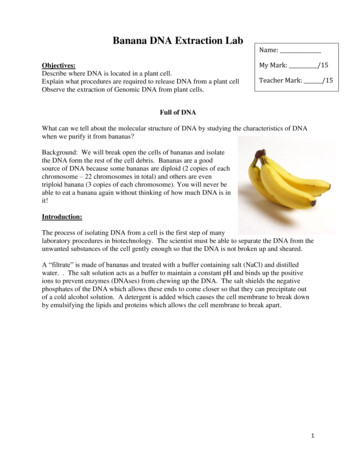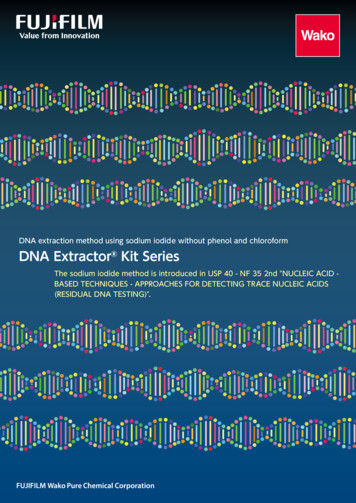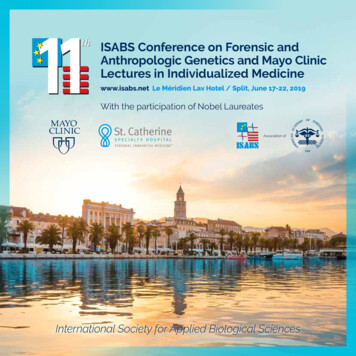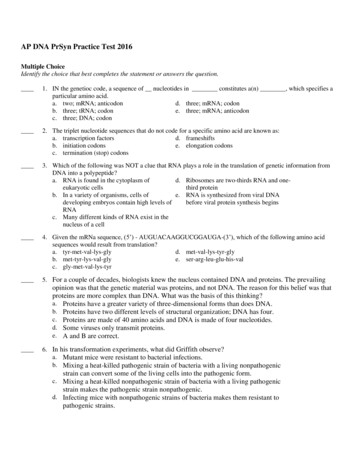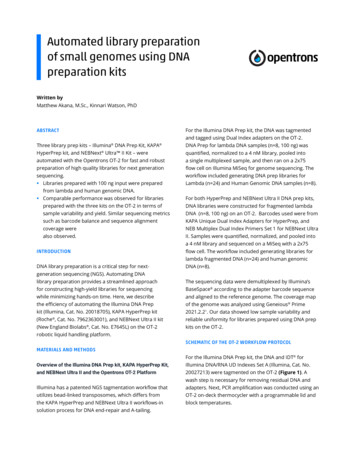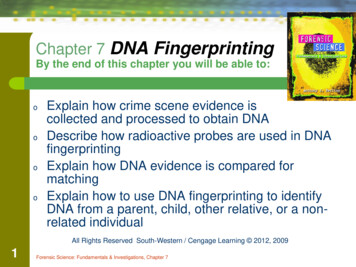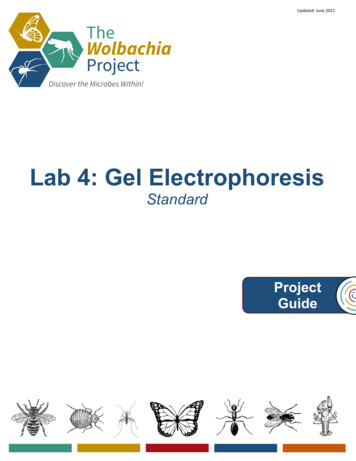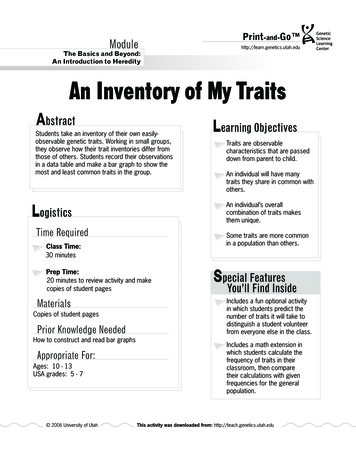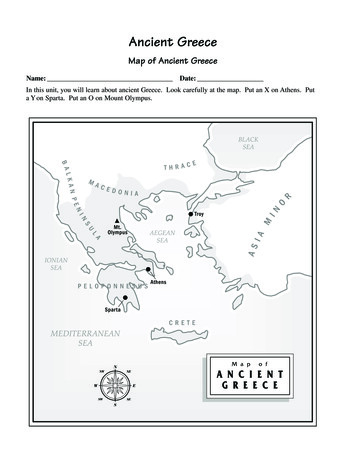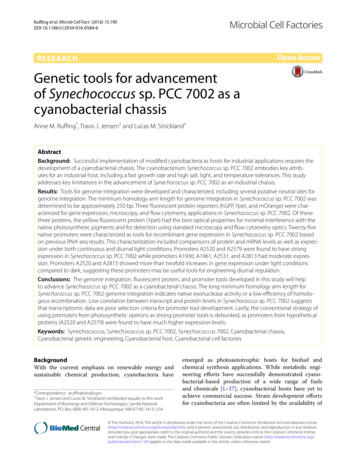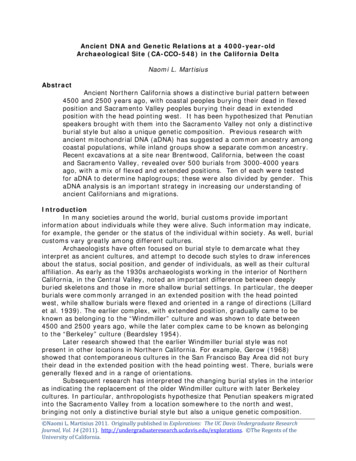
Transcription
Ancient DNA and Genetic Relations at a 4000-year-oldArchaeological Site (CA-CCO-548) in the California DeltaNaomi L. MartisiusAbstractAncient Northern California shows a distinctive burial pattern between4500 and 2500 years ago, with coastal peoples burying their dead in flexedposition and Sacramento Valley peoples burying their dead in extendedposition with the head pointing west. It has been hypothesized that Penutianspeakers brought with them into the Sacramento Valley not only a distinctiveburial style but also a unique genetic composition. Previous research withancient mitochondrial DNA (aDNA) has suggested a common ancestry amongcoastal populations, while inland groups show a separate common ancestry.Recent excavations at a site near Brentwood, California, between the coastand Sacramento Valley, revealed over 500 burials from 3000-4000 yearsago, with a mix of flexed and extended positions. Ten of each were testedfor aDNA to determine haplogroups; these were also divided by gender. ThisaDNA analysis is an important strategy in increasing our understanding ofancient Californians and migrations.IntroductionIn many societies around the world, burial customs provide importantinformation about individuals while they were alive. Such information may indicate,for example, the gender or the status of the individual within society. As well, burialcustoms vary greatly among different cultures.Archaeologists have often focused on burial style to demarcate what theyinterpret as ancient cultures, and attempt to decode such styles to draw inferencesabout the status, social position, and gender of individuals, as well as their culturalaffiliation. As early as the 1930s archaeologists working in the interior of NorthernCalifornia, in the Central Valley, noted an important difference between deeplyburied skeletons and those in more shallow burial settings. In particular, the deeperburials were commonly arranged in an extended position with the head pointedwest, while shallow burials were flexed and oriented in a range of directions (Lillardet al. 1939). The earlier complex, with extended position, gradually came to beknown as belonging to the “Windmiller” culture and was shown to date between4500 and 2500 years ago, while the later complex came to be known as belongingto the “Berkeley” culture (Beardsley 1954).Later research showed that the earlier Windmiller burial style was notpresent in other locations in Northern California. For example, Gerow (1968)showed that contemporaneous cultures in the San Francisco Bay Area did not burytheir dead in the extended position with the head pointing west. There, burials weregenerally flexed and in a range of orientations.Subsequent research has interpreted the changing burial styles in the interioras indicating the replacement of the older Windmiller culture with later Berkeleycultures. In particular, anthropologists hypothesize that Penutian speakers migratedinto the Sacramento Valley from a location somewhere to the north and west,bringing not only a distinctive burial style but also a unique genetic composition. Naomi L. Martisius 2011. Originally published in Explorations: The UC Davis Undergraduate ResearchJournal, Vol. 14 (2011). ons. The Regents of theUniversity of California.
Explorations: The UC Davis Undergraduate Research Journal, Vol. 14 lorationsBy contrast, populations in the Bay area remained in place. Support for thesenotions comes from previous mitochondrial DNA (mtDNA) research, which suggestscommon ancestry among coastal populations, with inland groups showing separateancestry.This research seeks to test these ideas using a recently excavated sitelocated between the Central Valley and the Bay area. The site, CA-CCO-548, or theMarsh Creek site, contains a mixture of both Windmiller-style and Berkeley-styleburials. Figure 1 shows both burial styles as excavated at the Marsh Creek site.Radiocarbon dating shows that these interment styles are contemporaneous at thesite. This paper tests the hypothesis that the site contains a mixture of people withCentral Valley (i.e., Windmiller) and Bay area (i.e., Berkeley) affiliations. I comparemtDNA extracted from both extended and flexed burials and examine whether thedata better fit a Central Valley-like or Bay area-like distribution of mitochondrialhaplogroups.A second hypothesis concerns post-marital residence patterns. Patrilocalityshould cause females to be more genetically variable than males. Ethnographically,tribes in this area were patrilocal, but the antiquity of patrilocality is unknown. Ifwe assume that historic tribes in the region were the same groups that replacedWindmiller populations, and that post-marital residence patterns are conservativeover time, the presence of a matrilocal pattern in the ancient population maysupport the population replacement hypothesis. Figure 2 shows the location of theMarsh Creek site, and other regional sites to which it will be compared in this study.2
Explorations: The UC Davis Undergraduate Research Journal, Vol. 14 lorationsFigure 1: Burial 78 (extended; haplogroup C) and Burial 79 (flexed). Photomodified from Randy Wiberg, 2010.3
Explorations: The UC Davis Undergraduate Research Journal, Vol. 14 lorationsFigure 2: Map of study area showing location of CCO-548 and other archaeologicalsites.BackgroundArchaeologists, anthropologists, and ethnographers, among others, havecollected vast amounts of data on the prehistory of California, and have shown thatancient California had complex societies with multiethnic groups cooperatingtogether. Archaeological evidence shows that California was occupied as early as10-13,000 years ago (Connolly et al 1995; Erlandson 2002; Johnson et al 2000;Rick and Erlandson 2000; Rick et al 2001); this date suggests a coastal migrationinto the area, since no other sites with comparable dates have been found inland.Some DNA evidence is also congruent with this probability; similar geneticfrequencies among coastal communities extending along a great portion of theCalifornia coast lend support to an early coastal migration (Eshleman 2004). Sitesall over California show times of bountiful resources with periods of resourcedepressions in between. Californians left no ecosystem unaltered, and used avariety of hunting and gathering techniques depending on the resources available.Broad trade-networks were established between coastal and inland peoples withintermarriage and gene transfer likely as well. The diversity of California’s ecologynecessitated different types of settlements across the landscape, as did California’slong period of habitation along with the variety of population density andtechnological innovations (Arnold 2004).It has been long suggested that population movements are correlated withthe spread of languages. It may be too difficult to determine what languages theearliest inhabitants of the Americas spoke, but precursors to known languages in4
Explorations: The UC Davis Undergraduate Research Journal, Vol. 14 lorationsCalifornia may have arisen as early as 6000 to 4000 BC during a time of globalwarming (see Antevs 1952). Recognizable language groups – Hokan, Penutian,Yukian, and Uto-Aztecan – have their roots in the time period directly following thisperiod, from 4000 to 2000 BC. Michael Moratto (1984) suggests that Hokanspeakers were the predominant population in California during this period, while inthe ensuing period, from 2000 BC to 1 AD, Penutian and Uto-Aztecan languagespeakers displaced many Hokan speakers. Moratto based his hypothesis on thepresence of Windmiller sites in the Sacramento Valley beginning about 2000 BC.According to Moratto’s hypothesis, these Windmiller peoples should be the firstPenutian speakers.For a long while, anthropologists believed that Windmiller sites were notvillages but mortuary mounds instead. C.W. Meighan worked on SJo-68 as a youngstudent and offered several lines of evidence to support this conclusion (Meighan1987). He noticed that burials were very close together during different timeperiods, and believed this was indicative of a cemetery because graves would bedisturbed if they were directly inside a village. The lack of domestic types ofartifacts also supports that this site was not a village. He also examined thephysical nature of the site and made comparisons with other sites of the same ageas the Windmiller Culture to support his conclusions that SJo-68 was exclusively aburial mound (Meighan 1987).Recent excavations at the Marsh Creek site (CA-CCO-548) near Brentwood,California, between the coast and the Sacramento Valley revealed the presence of ahabitation village and numerous artifacts, as well as over 500 burials. These burialsexhibit a mix of flexed and extended positions, and their dates range from 3000 to4000 years ago, contemporaneous with SJO-68 and other Windmiller sites.Based on these observations, Nathan Stevens and colleagues (2009)challenge the long-held understanding that Windmiller burial mounds are notancient villages. They find evidence to determine cultural practices from the MarshCreek site, and show a difference between the Early Horizon cultures and the EarlyHolocene cultures. There seems to have been a peak in long-distance trading ofeastern obsidian with the Windmiller culture, and evidence shows a distinct,specialized diet of small mammals and small seeds that is less diverse than the dietof earlier cultures. Bartelink and colleagues (2010) employed stable isotopeanalysis to show that the inhabitants of Marsh Creek have carbon isotope ratiosconsistent with a mostly terrestrial diet, and nitrogen isotope values consistent withconsumption of a heavy vegetarian component of C3 plants. Previous research byBartelink (2006) also shows that the isotope values at other sites from the CentralValley that are classified as Windmiller are consistent with those found at CCO-548.On the other hand, isotopic data from a contemporaneous site in the Bay area, CAALA-307, the West Berkeley Shellmound, show a diet focused on high trophic levelmarine foods that is distinct from diets found further to the east (Bartelink 2009).In any case, the Marsh Creek site clearly shows distinct cultural practices, whichwould exclude it from being labeled as a burial mound.Both ancient and modern mtDNA studies have been useful in understandingthe population movements of ancient Californians. mtDNA is a small circulargenome that is distinct from the nuclear genome. It is found inside cells, butoutside the nucleus in the mitochondria. The high copy number of mtDNA allowsfor more readily obtainable samples compared with nuclear DNA. This is very5
Explorations: The UC Davis Undergraduate Research Journal, Vol. 14 lorationsimportant, since DNA degrades over time. Secondly, mtDNA is only inheritedthrough the mother, so maternal ancestry can be traced far back in time. Finally,mtDNA is not highly conserved, allowing mutations to accumulate fairly rapidly andleading to distinct lineages that are easily traceable.Native Americans were among the first populations to have their mtDNAstudied; consequently, there is a large amount of information on mtDNAhaplogroups from modern tribes as well as recovered ancient samples. Within theAmericas, there are five mtDNA haplogroups: A, B, C, D, and X. Haplogroups aredistinct lineages characterized by single nucleotide polymorphism (SNP) mutations.Haplogroup frequency distributions across the Americas are non-random and arehelpful in determining migrations of ancient peoples.In 2002, Eshleman examined mitochondrial DNA from three different sites inthe Central Valley of California with dates ranging from 1800 to 3600 years beforepresent. There were no considerable regional differences in the frequencies ofmtDNA haplogroups, which seems to signify genetic continuity in the area. Therewas evidence of a relationship between linguistic groups and mtDNA, which ishelpful for tracing population movements. mtDNA haplogroup frequencydistributions were compared between and among both ancient and modernpopulations in California. The Bear Creek site (aka Cecil site; CA-SJO-112) isassociated with Windmiller artifacts and burial practices and has dates comparableto those of the Marsh Creek site. The Cook (CA-SOL-270) and Applegate (CA-AMA56) sites post-date the Windmiller burials and represent Middle Horizon cemeteries.Analyses showed that the three sites have haplogroup frequencies that arerelatively similar to one another, with the largest proportion of individuals belongingto haplogroup C, and haplogroups B and D occurring with less frequency. Only onemodern language family group, Takic, exhibits haplogroup frequencies similar tothat of the ancient Central Valley.In sum, the previous mtDNA evidence does not support the hypotheses of aninflux of Penutian peoples into Central California associated with Windmillerartifacts. Instead, the evidence suggests multiple migrations and admixture overtime. There is no evidence for any relationship between these ancient populationsand modern Penutian peoples. A more recent migration into the area is moreconsistent with the change in haplogroup frequencies (Eshleman 2002).The San Francisco Bay Area shows different haplogroup frequenciescompared with the Sacramento Valley sites. A recent study at the Yukismacemetery site (CA-SCL-38) near Santa Clara, California, presents mtDNA resultsfrom 66 individuals. This site includes burials from the middle to late periods,which are contemporaneous with the Cook and Applegate sites. The majority ofindividuals at the Yukisma cemetery site belonged to haplogroup D, with smallerproportions represented for haplogroups A, B, and C (Monroe et al. 2011). Thishaplogroup frequency is statistically different from the Sacramento Valley sites(p 0.009; the 0.05 probability level was corrected using Bonferroni’s Correction to 0.017 [Abdi 2007]), and more closely resembles that of other San FranciscoBay sites.Geographically, the Marsh Creek site is intermediate between the SanFrancisco Bay and the Sacramento Valley. mtDNA analysis at this site withcomparisons between other sites in the greater area will help to close the gap in ourunderstanding of ancient California.6
Explorations: The UC Davis Undergraduate Research Journal, Vol. 14 lorationsMaterials and MethodsTwenty teeth from the Marsh Creek site were collected from twenty burialswith calibrated radiocarbon dates ranging from 3100 to 3800 years before present.Half the samples came from extended burials, while the other half came from flexedburials. These two sample types were further divided into male and femalecategories; the sex of each individual was determined at the Marsh Creek site usingmorphological features. mtDNA was extracted in the Molecular Anthropology Lab(MAL) at UC Davis following the protocol outlined by Kemp et al. (2006) and Kempand Smith (2005).A series of steps was taken to prepare the samples for extraction in theaDNA facilities of the MAL. Each tooth had a portion of the root removed(approximately 0.08g), which was then soaked in 6% household bleach to removeany outside contaminates (Kemp and Smith 2005). After the samples were rinsedwith ddH2O, they were then placed into 2 ml of molecular grade 0.5 M, pH 8.0,EDTA and mildly rocked for at least 2 days for calcium removal. The 3-dayextraction process began by adding 90 ul of Proteinase K to each sample with a 65degree Celsius incubation period of at least 4 hours, with most left overnight.The second day consisted of a phenol-chloroform extraction, which wascarried out in three steps. The first two extractions used 2ml of phenol-chloroform,while the third extraction used 2ml of chloroform. Following each extraction thesamples were centrifuged for 5 minutes to separate the extracted DNA from thephenol-chloroform/chloroform. Once this process was complete, the DNA wasprecipitated with 100% isopropanol and 5 M ammonium acetate overnight at roomtemperature to ensure the removal of PCR inhibitors. On the third day, thesamples were centrifuged at 4000 rpm for a half hour to pellet the DNA. Pelletswere then washed with 1 ml 80% ethanol and then centrifuged again for 30minutes. After allowing the pellet to dry for 15 minutes, the samples wereresuspended in 300 ul of ddH2O and then purified with Wizard PCR PrepsPurification System as the manufacturer directed. The DNA was finally eluted with100 ul of ddH2O.After extraction, polymerase chain reaction (PCR) and Restriction FragmentLength Polymorphism (RFLP) were used to determine the haplogroup of eachindividual. Specific regions of the mtDNA that contained mutations specific tohaplogroups A, B, C, D, and X were amplified in a different laboratory from theaDNA facility. PCR was carried out using a 13.5 ul cocktail of ddH2O, dNTPs, 10XPCR buffer, MgCl2, and Platinum Taq DNA polymerase with at least 1.5 ul of theDNA template. The DNA was amplified using cycling conditions described in Kempet al. (2006). The amplified product of expected sizes was then confirmed byelectrophoresis on polyacrylamide gels. At this point, samples belonging tohaplogroup B could then be determined, as they exhibit a shorter fragment lengthdue to a 9 base pair deletion. Restricting fragment length polymorphisms werethen determined by digesting the DNA fragments using the following enzymes: HAEIII for haplogroup A, Alu I for haplogroups C and D, and Acc I for haplogroup X.Each enzyme, along with a cocktail of ddH2O, buffer, and BSA, was added to thePCR product, which was then incubated for 9 hours at 37 degrees Celsius. Thisfinal product was then run on a polyacrylamide gel to check for haplogroupdiagnostic digestion. Haplogroups A, C, and X were identified by single restrictionsite gains, while haplogroup D was identified by a site loss.7
Explorations: The UC Davis Undergraduate Research Journal, Vol. 14 lorationsEach sample was extracted on at least two separate occasions to ensureconfirmation of haplogroups determined. Protocols were taken to limit any outsidesources of contamination at all steps: counters and instruments were bleachedbefore and after every use; gloves were changed frequently and in betweendifferent processes; containers were kept closed at all times while not in use; itemswere not brought back to the aDNA facility from the PCR room without beingbleached first; negative controls were used to ensure there had been nocontamination.Fisher’s exact probabilities were conducted between haplogroup frequencydistributions of several ancient California sites. Fischer’s exact test was also usedto compare the haplogroup frequencies between burial types at the Marsh Creeksite. Calculations were performed using Genepop (Raymond and Rousset 1995).Table 1 lists the samples included in this analysis.Table 1: Burials included in the current analysis, and associated demographicinformation.14Burial #SexBurial PositionC DateHaplogroup14FemaleFlexed3145 36D26FemaleFlexed3255 32UE31MaleExtendedNo dataUE37FemaleExtended3050 30B78FemaleExtended3010 40C*81FemaleFlexed3080 26UE82MaleFlexed2975 26UE105MaleFlexed3470 36D107MaleExtended3505 31UE116IndeterminateExtended3420 41UE135FemaleExtended3195 31C142MaleExtended3100 31UE162FemaleFlexed3425 26UE163MaleFlexed3470 25UE182MaleExtended3500 41UE203FemaleExtended3090 36C210MaleFlexed3440 26B217MaleFlexed3615 26UE292FemaleFlexed3050 41C*310FemaleExtendedNo dataUENotes: UE Unsuccessful extraction; * confirmed through two extractionsRadiocarbon dates are from Gardner, Bartelink, and Eerkens, unpublished data.8
Explorations: The UC Davis Undergraduate Research Journal, Vol. 14 lorationsResultsTo date, of the twenty samples extracted for mtDNA, only eight haplogroupscould be determined with limited confirmation. These eight samples were assignedto one of the five haplogroups native to the Americas. Results are preliminary andmore data is needed for confirmation.Of the extended burials, four females were assigned to haplogroups. Burial37 was found to belong to haplogroup B, while Burials 78, 135, and 203 belongedto haplogroup C. Of the flexed burials, four haplogroups were also assigned. Burial14, a female, and Burial 105, a male, were found to belong to haplogroup D, whileBurial 210, a male, belonged to haplogroup B and Burial 292, a female, belonged tohaplogroup C. Of all these samples, only Burial 78 and Burial 292 were confirmedthrough two separate extractions (see Table 1). While standard aDNA protocolgenerally requires that samples provide double confirmation of results, we are stillconfident that those samples that could not be amplified for a confirmation belongto the haplogroup to which they were assigned. As no one in the aDNA laboratorybelongs to the haplogroups noted here, and preventative measures againstcontamination were taken at all steps, the chance that the haplogroup assignmentshere are not endogenous to the sample is slim.Fischer’s exact test showed that the frequency of haplogroups between thetwo burial styles (extended vs. flexed) at Marsh Creek (CA-CCO-548) was notsignificantly different. As a whole, Marsh Creek’s haplogroup frequencies were alsocompared with the Bear Creek site (CA-SJO-112), the Cook site (CA-SOL-270), theApplegate site (CA-AMA-56), and the Yukisma cemetery site (CA-SCL-38). Resultsshowed that the haplogroup frequencies of Marsh Creek were not significantlydifferent from any of the four other sites. However, the same test showed that CASCL-38 is significantly different from all other sites except Marsh Creek (p 0.009;the 0.05 probability level was corrected using Bonferroni’s Correction to 0.017[Abdi 2007]).Discussion and ConclusionsWith such a limited sample size at Marsh Creek, any patterns in ancestry andancient migrations are tenuous, but Fisher’s exact test suggests an interestingpattern. The site from the San Francisco Bay (CA-SCL-38) shows haplogroupfrequencies that are statistically different from the three sites in the SacramentoValley, suggesting two separate populations with limited gene flow. Geographically,Marsh Creek is situated between these two areas; haplogroup frequencies do notseem to be statistically different from any of the populations. In other words, theMarsh Creek site seems to be intermediate between San Francisco Bay andSacramento Valley sites not just geographically but also genetically.The comparison between haplogroup frequencies of burial types at the MarshCreek site shows no significant difference, but one that, with such a small samplesize, yields a low degree of confidence. Also, with only two male haplogroupsassigned, no residence patterns can confidently be determined. More research isneeded to better understand these relationships. In the future, the mtDNAhypervariable region of these samples should be sequenced to better understandpopulation relationships in California, and adding more individuals to the samplesize will help to reduce any sampling errors. Despite its limitations this aDNA9
Explorations: The UC Davis Undergraduate Research Journal, Vol. 14 lorationsanalysis is important in closing the gap in our understanding of ancient Californiapeoples.AcknowledgementsFirst and foremost I would like to expressly thank Ramona Garibay, the mostlikely descendant, for allowing this research to happen. In addition, special thanksgo to Randy Wiberg for site excavation, the National Science Foundation (grant#BCS-0819968) for funding the radiocarbon dating, and Dr. Jelmer Eerkens, mysponsor, for providing me with excellent guidance throughout. Also, I would like tothank Dr. David Smith for allowing me the use of his Molecular Anthropology Laband the help of his staff and students, including Dr. Meradeth Snow, who trained,mentored, and guided me with patience through this process.ReferencesAbdi H. 2007. Bonferroni and Sidak corrections for multiple comparisons. In:Salkind, NJ (Ed.), Encyclopedia of Measurement and Statistics. Sage,Thousand Oaks, CA.Antevs E. 1952. Climatic history and the antiquity of man in California. University ofCalifornia Archaeological Survey Reports 16: 23-31.Arnold JE, Walsh MR, and Hollimon SE. 2004. The archaeology of California. Journalof Archaeological Research 12:1-73.Bartelink EJ. 2006. Resource Intensification in Pre-Contact Central California: ABioarchaeological Perspective on Diet and Health Patterns among HunterGatherers from the Lower Sacramento Valley and San Francisco Bay. PhDDissertation, Texas A&M University. Published dissertation. Ann Arbor, MI:University Microfilms.Bartelink EJ. 2009. Late Holocene dietary change in the San Francisco Bay Area:Stable isotope evidence for an expansion in diet breadth. CaliforniaArchaeology 1(2):227-252.Bartelink EJ, Beasley MM, Eerkens J, Gardner KS, and Jorgenson G. 2010. Chapter20: Paleodietary analysis of human burials: Stable carbon & nitrogen isotoperesults. CA-CCO-18/548: Vineyards at Marsh Creek Project.Beardsley RK. 1954. Temporal and areal relationships in Central Californiaarchaeology. Reports of the University of California Archaeological Survey 2425.Connolly TJ, Erlandson JM, and Norris SE. 1995. Early Holocene basketry andcordage from Daisy Cave, San Miguel Island, California. American Antiquity60: 309–318.Erlandson JM. 2002. Anatomically modern humans, maritime voyaging, and thePleistocene colonization of the Americas. In Jablonski, N. G. (ed.), The FirstAmericans: The Pleistocene Colonization of the New World, Memoirs of theCalifornia Academy of Sciences 27, San Francisco. 59–92.Eshleman JA. 2002. Mitochondrial DNA and prehistoric population movements inWestern North America. Dissertation 64-123.Eshleman JA, Malhi RS, Johnson JR, Kaestle FA, Lorenz J, and Smith DG. 2004.Mitochondrial DNA and prehistoric settlements: native migrations on thewestern edge of North America. Human Biology 76: 55-75.10
Explorations: The UC Davis Undergraduate Research Journal, Vol. 14 lorationsGerow B.A. (with RB Force). 1968. An Analysis of the University Village Complexwith a Reappraisal of Central California Archaeology. Stanford UniversityPress, Stanford.Johnson JR, Stafford TW Jr., Ajie HO, and Morris DP. 2000. Arlington Springsrevisited. In Browne, D. R., Mitchell, K. L., and Chaney, H. W. (eds.),Proceedings of the Fifth California Islands Symposium. U.S. Department ofthe Interior, Washington, DC. Pp. 541–545.Kemp BM and Smith DG. 2005. Use of bleach to eliminate contamination DNA fromthe surfaces of bones and teeth. Forensic Science International 154, 53-61.Kemp BM, Monroe C, and Smith DG. 2006. Repeat silica extraction: a simpletechnique for the removal of PCR inhibitors from DNA extracts. Journal ofArchaeological Science 33, 1680-1689.Lillard J.B., Heizer RF and Fenenga F. 1939. An Introduction to the Archaeology ofCentral California. Sacramento Junior College, Department of AnthropologyBulletin 2.Meighan CW. 1987. Reexamination of the early central California culture. AmericanAntiquity 52: 28-36.Monroe C, Villanea F, Leventhal A, Cambra R, and Kemp BM. 2011. Ancient humanDNA analysis from CA-SCL-38 burials: Correlating biological relationships andmortuary behavior. SAA 76th Annual Meeting, March 30-April 3, 2011,Sacramento, CA.Moratto M. 1984. California Archaeology. Academic Press. 543-573.Raymond M and Rousset F, 1995. GENEPOP (version 1.2): Population geneticssoftware for exact tests and ecumenicism. J. Heredity, 86:248-249.Rick TC, and Erlandson JM. 2000. Early Holocene fishing strategies on the Californiacoast: Evidence from CA-SBA-2057. Journal of Archaeological Science 27:621–633.Rick TC, Erlandson JM, and Vellanoweth RL. 2001. Paleocoastal marine fishing onthe Pacific Coast of the Americas: Perspectives from Daisy Cave, California.American Antiquity 66: 595–613.Stevens NE, Eerkens JW, Rosenthal JS, Fitzgerald R, Goosell JE, and Doty J. 2009.Workaday Windmiller: Another look at early horizon lifeways in centralCalifornia. SCA Proceedings 23: 1-8.Wiberg RS. 2010. Archaeological Investigations at CA-CCO 18/548: Final Report forthe Vineyards at Marsh Creek Project, Contra Costa County, California.Holman and Associates, San Francisco, CA.11
Ancient Northern California shows a distinctive burial pattern between 4500 and 2500 years ago, with coastal peoples burying their dead in flexed . as the Windmiller Culture to support his conclusions that SJo-68 was exclusively a burial mound (Meighan 1987). Recent excavations at the Marsh Creek site (CA-CCO-548) near Brentwood, .
